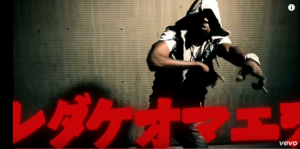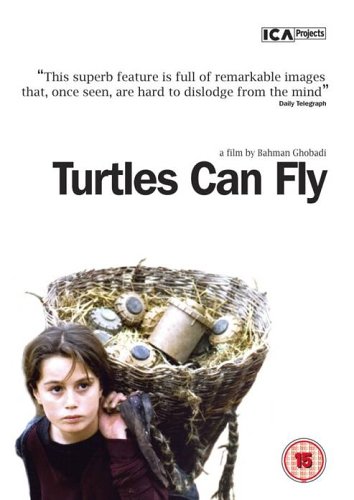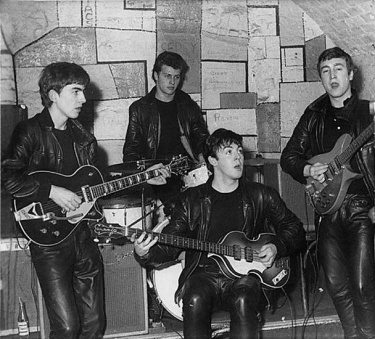Anyone who claims that Kanye is not an influential artist in today’s culture industry must not understand the definition of the word influential. At least in the eyes of a college-aged consumer of popular media like myself, Kanye is quite the trendsetter. He has mastered the art of appealing to the people from the beginning of his career, introducing some relatively innovative achievements when the market asks for it and playing along with current trends when the industry is stable. “Stronger”, one of his most well known early career songs, is a great example of this.The successful video stays within the comfort zone of the still-popular trend of mimicking a stereotypical Japanese anime style of film. Yet, even as a trend setter, Kanye was not the first in popularizing Japanese themes in pop culture. Such appropriation was happening well before Kanye came along. In fact, tracing the roots of using Japanese themes in popular culture traces back well into the late 1800’s.
As Koichi Iwabuchi puts it, “Japanese cultural presence tends to be culturally odorless…” (Iwabuchi), the use of Japanese culture is more present than many people, including consumers, seem to recognize. As inconspicuous Japanese culture appears, however, and although Japan may seem a “faceless economic superpower with a disproportionate lack of cultural influence upon the world… [that] has money and technologies but cannot diffuse its culture…” in actuality it has “long been exporting cultural products overseas.”(Iwabuchi) Beginning as early as the early 1900’s, around the time of the Russo-Japanese war, with artists interest in Japanese painting styles, then the late 1950’s and early 1960’s, as America rebuilt its relationship with Japan, with writers and poets, and now at the end of the 20th century and into the 21st century, the incorporation of Japanese themes has been arriving to the United States in waves that appear to correspond with the U.S’s political relationship with Japan.
The emergence of Japan-inspired art in the final decade of the 20th century and the beginning of the 21st century, however, does not connect with this idea of political ties to the cultural industry as well as other eras. It is difficult to identify one major political “stepping stone” that could have lead to the emergence of the interest of Japanese themes, suggesting that perhaps social movements are driving the waves. In fact, Koichi Iwabuchi addresses this idea, pushing aside the political correlation proposal and suggesting there is a cultural-social facet that makes Japanese cultural especially attractive to artists. He writes “While the spread of Japanese media culture into the United States and Europe has been a gradual and steady phenomenon since at least the 1980s, it has intensified in the new millennium, so much so that we have recently witnessed the rise of a “cool Japan”…” (Iwabuchi) But what is it that Americans suddenly find “cool” enough to appropriate?
Through appropriating Japanese culture, the American culture industry is repurposing traditional themes in a way that satisfies needs of the industry. In the current case, it appears the U.S. appropriates the culture of Japan in appreciation and in desire to explore its multiple “cool” characteristics, notably its advanced technology. Historically Japan has been at the forefront of many technological movements, and the U.S. culture industry plays that feature up in movies and music videos, often associating robotics and exclusive technology (like cars and computers) with Japanese characters, Japanese words and/or subtitles, or even cities within Japan itself. The appreciation of technology, however, doe not arrive alone into the culture industry in the United States.
Japan has also come to be known in American for its notable polar gender roles. To many people in the U.S., male samurais have developed into topics of interest, representing astonishingly tough manly qualities. Geishas, in a similar way, have become of interest as they hold a marked role in gender relations and have had the image of their subservient roles intensified by U.S media. Both roles emphasize honor and discipline in their own unique ways. Today’s infatuation with Japanese culture shows many signs of being based in technology, but also brings up the desire to explore these gender roles. As Roland Kelts of Japanamerica puts it, “There are always some americans interested in iconic totems of Japanese culture, like the bushido samurai tradition that emphasizes honor and discipline… it is the eccentricities, spastic canniness, and libertarian fearlessness of Japan’s creators of popular culture… that are attracting the attention of Americans.”(Kelts)
The infatuation, especially in today’s music video industry, however, has become more and more problematic in the things it focuses on when appropriating. Artists exaggerate features of Japanese culture making it seem much more childish through costume and prop choice. Paired with this we often see some other Japanese themes like sakura trees or kimonos, making the childish aspects seem like a natural not re-appropriated aspect of Japanese culture. Appropriating in such a way, as excellently put by Gayle Wald, using “Such infantilizing images of Japanese women rockers are, of course, [is] merely the benign complement to a more overtly and aggressively racist neocolonial portraiture of Asian femininity”(Wald)
Take Gwen Stefani’s Hollaback Girl music video for example. The song, about not being the type of girl who responds positively to cat calls and such, is accompanied by a music video that starts with Gwen taking a picture of a group of exclusively Japanese friends and calling them “super kawaii.” She then breaks out into song and dance, with her Japanese posse always hovering in the background. The rebellious nature of Gwen Stefani, and showing her lead a group of asian women into rebellion, juxtaposes the traditional role of what appropriated Japanese themes are usually interpreted as. Yet, even through the “empowering” of her Japanese followers, there is a heightened sense that all other women who are not represented by Gwen’s crew are subservient. Gwen is contrasted to the background group in a way that makes her appear rowdy and takes orders from no one. The Japanese girls, on the other hand, are depicted similar to each other, trying to follow their leader, Gwen.


In more recent times, we see an even more intense use of Japanese culture to reaffirm the sub-ordinance of women. Katy perry, for example, in the 2013 AMA’s, wears geisha attire as she sings about an unconditional love, thus emphasizing the role of women as caring devoted figures in male life and emphasizing the idea of geisha subservience. Even the background dancers reaffirm this idea. Continuously throughout her performance, background dancers are running up to Katy Perry, dressed in their own kimonos, completing various tasks like brining her an umbrella, and fanning her, metaphorically screaming at the audience to look at their ability to obey.
The intensity of which Japanese culture is appropriated seems to only grow from there.There is no doubt Avril Lavigne carries a pop-punk rebel persona, and her songs are often about forgetting about any institutionalized systems and breaking the rules. Unclear if she does it to thumb her nose at appropriation, she still manages to fall into the group of artists that appropriates Japanese cultures in regards to gender roles with her video to “Hello Kitty”. Epitomizing appropriation of Japanese culture in the 21st century, Avril Lavigne bounces around in a cupcake skirt through candy stores and sushi bars. Lurking in the background of nearly every shot is a squad of identical looking Japanese girls that stay quite, and serve what seems to juxtapose Avril Lavigne. Performing for the pleasure of the viewer and stays quite and obedient as traditional geishas did, it appears they are modern day Americanized standard geishas.
An understandable argument raised when thinking about the appropriation of culture in such a way is how people are to express their appreciation for other cultures? In her performance of Unconditionally, Katy Perry includes other Japanese themes, such as waves reminiscent of the “Great Wave of Kanagawa” painting, and projections of Japanese style art in the background, showing interest in other aspects of the culture. As Perry said in one interview “I guess I’ll just stick to baseball and hot dogs, and that’s it … can’t you appreciate a culture? I guess, like, everybody has to stay in their lane?” (Rolling Stone) It does not seem likely that these artists are appropriating Japanese culture specifically to point out the subservience of women.
Appreciating the culture, however, is a difficult task to accomplish via industry driven performance. Taking themes out of context and reapplying them to new scenarios is incredibly hard to accomplish without either making a spectacle of the foreign culture or using it to represent some other value. The Chicago Monitor, in a notably blunt post, spelled it out well what “appreciation” in pop culture has turned into, “When she [Katy Perry] abuses her societal privilege as a white woman and associates geishas with unconditional love, she reinforces the patriarchal and Orientalist idea that Asian women are passive, docile, and childlike in their servitude to men.”(Mohamed) This is not to say that appropriation is all together a terrible thing that only ultimately results in creating a false image of other culture’s value, but the fact of the matter is that it usually results in reinforcing ideas that are not meant to be represented. It is not that appropriating should be entirely avoided, but it is hard to get it right. Katy Perry, Gwen Stefani, and Avril Lavigne have all expressed some interest in feminism, and yet through their appreciation they exotics Japanese culture and depict it and advocate antifeminist themes.

Adopting one theme from a new culture is ultimately tied to adopting multiple themes to make the initial incorporation of said theme more natural. We chose to include Japanese driven technology into popular culture because it is cool and historically we associate Japanese with advance technology. Naturally, we can’t adopt that single aspect of Japanese culture without expressing some other realm of Japanese culture. Through such appropriation the purpose of Japan culture in the U.S. turns into a way of reinforcing misogynistic ideology, and develop the image of Japan into a place where women are childlike and submissive. The individual aspects of culture, like gender and race, are more closely tied together than we realize. The fact of the matter is that adopting one theme from a new culture is ultimately tied to adopting multiple themes to make the adoption of said theme more natural.
Work Cited:
I would like to thank Williams College professor Anthony Sheppard for sharing his insight of the role Japan has played in the American music industry with me.
Iwabuchi, Koichi. “‘Marketing ‘Japan’: Japanese cultural presence under a global gaze” Japanese Studies 18.2 (1996): 257-258. Online.
Iwabuchi, Koichi. “‘Marketing ‘Japan’: Japanese cultural presence under a global gaze” Japanese Studies 18.2 (1996): 256. Online.
Iwabuchi, Koichi. “Uses of Media Culture, Usefulness of Media Culture Studies: Beyond Brand Nationalism into Public Dialogue”. Creativity and Academic Activism: Instituting Cultural Studies. Ed.
Meaghan Morris and Mette Hjort. Hong Kong University Press, 2012. 140. Web.
Kelts, Roland. Japanamerica: How Japanese Pop Culture Has Invaded the U.s. New York: Palgrave Macmillan, 2006. Print.
Wald, Gayle. “Just a Girl? Rock Music, Feminism, and the Cultural Construction of Female Youth”. Signs 23.3 (1998): 585–610. Web.
“The Unbreakable Katy Perry: Inside Rolling Stone’s New Issue.” Rolling Stone. Rolling Stone, 30 July 2014. Web. 15 May 2016.
Mohamed, Hanan. “Appropriating Black, Asian, and Islamic Culture for Entertainment.” The Chicago Monitor. The Chicago Monitor, 6 July 2015. Web. 15 May 2016.







